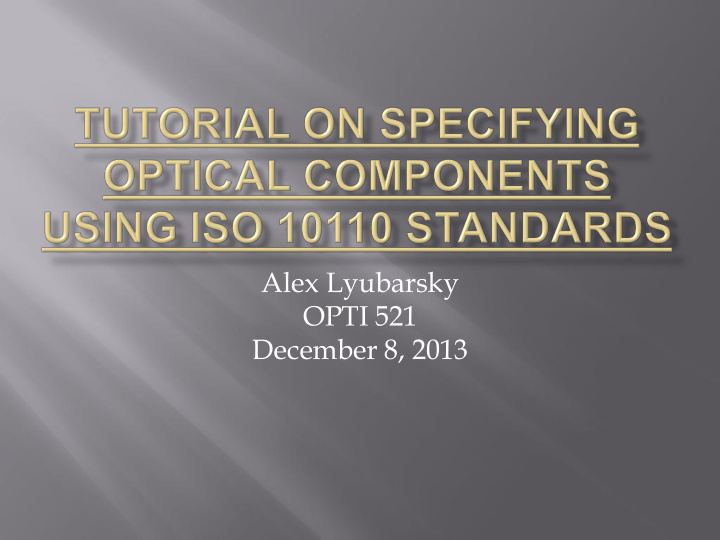



Alex Lyubarsky OPTI 521 December 8, 2013
Introduction to Optical Specification Standards (Section 1) Sections 2-13 of ISO 10110 Standard Specification ISO 10110 Drawings Q & A
ISO 10110 standard created to provide universal understanding of drawings and specifications of optics 13 sections with detailed description on how to specify optical components GD&T mechanical drawings practices apply First-angle projection (not third angle) Other optical standards: ASME/ANSI Y14.18M-1986 MIL-STD-34 DIN 3140
Part Title Indication 1 General N/A 2 Material imperfections – Stress birefringence 0/ 3 Material imperfections – Bubbles and Inclusions 1/ 4 Material Imperfections – Inhomogeneity and Striae 2/ 5 Surface form tolerances 3/ 6 Centering Tolerances 4/ 7 Surface Imperfection tolerances 5/ 8 Surface Texture 9 Surface Treatment and coating 10 Table representing data of a lens element N/A 11 Non tolerance data N/A 12 Aspheric surfaces N/A 13 Laser irradiation damage threshold 6/
Stress Birefringence (sec. 2) Anisotropic index of refraction across an optic A= Δs/a=Kσ Indication: 0/A in nm/cm Δs = optical path difference (nm) a = sample thickness (cm) K = stress optic coefficient difference (nm/cm)/(kg/mm 2 ) σ = stress (kg/mm 2 ) Bubbles and inclusions (sec. 3) Bubbles: Pockets of trapped gas within the glass Inclusions: Opaque or highly scattering regions within glass Indication: 1/NxA, where N is # of max. sized defects, A is grade # in mm of the max. size defect allowed Inhomogeneity and striae (sec. 4) Inhomogeneity: Variation of index of refraction within an optics Striae: localized changes of the index of refraction Indication: 2/A;B, where A, B are the class #s for homogeneity and striae
Indication: 3/A(B/C) RMSs < D (all Ø …) Tolerance place holder and name Tolerance definition This is the P-V deviation of the best fit sphere from a sphere with A Saggita tolerance the nominal radius of curvature. The P-V error relative to the best fit spherical surface. B Irregularity Rotationally symmetric The P-V of the best fit aspheric surface. C irregularity RMS departure from a sphere with the nominal radius of curvature. RMS t RMS departure from the best fit spherical surface. D RMS i RMS departure from the best fit aspheric surface. RMS a Size of Aperture over which the surface form tolerances apply. (all Ø …)
Specification of surface tilt and edge run-out (ERO) Indication: 4/σ or 4/σ(L), where σ max. tilt (arc -min or arc-sec), L is max lateral displacement (mm)
Specification of Scratches and digs Indication: 5/NxA; LZ x F N = max. # of digs A = max size of digs (mm) Z = max. # of scratches F = width of widest scratch (mm) L = indicates “long scratch”
Matte Surfaces – Grinded or chemically etched Intentionally scatter light diffusely into large angles Specular Surfaces – produce very little scattered light Indication: See image below A = surface type (P for polished, G for ground) B = Indicates RMS or PSD measurement C = Indicates sampling length (mm)
Specification of surface treatment and coating AR, dichroic, reflective, etc. Indication: Lambda in a circle
Element drawing separated into 3 zones Zone 1: Typical drawing title block (name, part #, manufacturer, etc. ) Zone 2: Space for tabular lens data (3 fields) Field 1: Left surface specifications Field 2: Material specifications Field 3: Right surface specifications Zone 3: Illustration of part
Standard tolerances to a feature with non- toleranced data
Same rules apply to specifying aspheres Exceptions: Term “asphere” must be indicated on drawings along with equation Sag table provided on drawing Drawing indications for an ellipsoid
Defines the energy density which surface damage should not occur when surface is irradiated with a laser (units J/cm 2 ) Indication: Pulsed lasers: 6/H th ; λ; pdg; f p ; n TS x n P Continuous lasers: 6/E th ; λ; n TS λ = wavelength “ pdg ” = pulse duration group number from ISO 11254 “ f p ” = pulse repetition rate in Hz “ n TS ” = number of test sites on the sample surface “ n P ” = number of laser pulses applied to each site
Thank You
Homogeneity Class Numbers Striae Class Numbers
Kimmel, R. K., Parks, R. E., ISO 10110 Optics and Optical Instruments – Preparation of drawings for optical elements and systems: A User’s Guide , Second Edition, OSA, 1995. Yoder, P., Opto-Mechanical Systems Design, Third Edition, CRC Press, 2006.
Recommend
More recommend